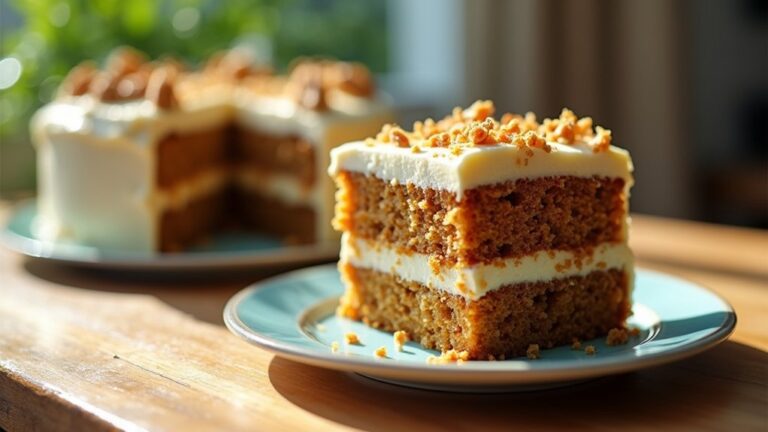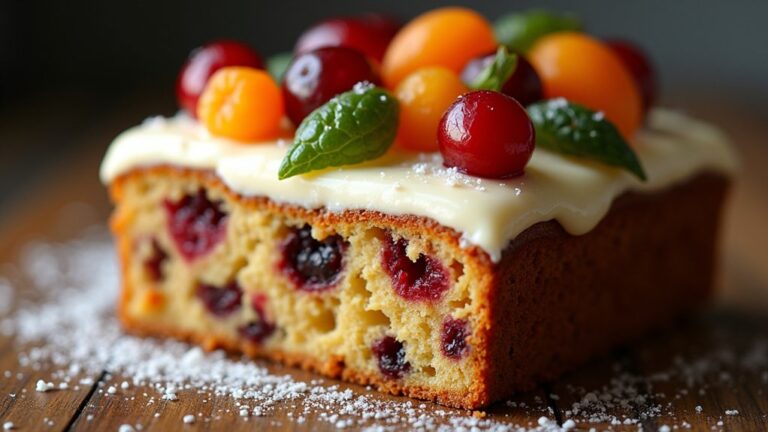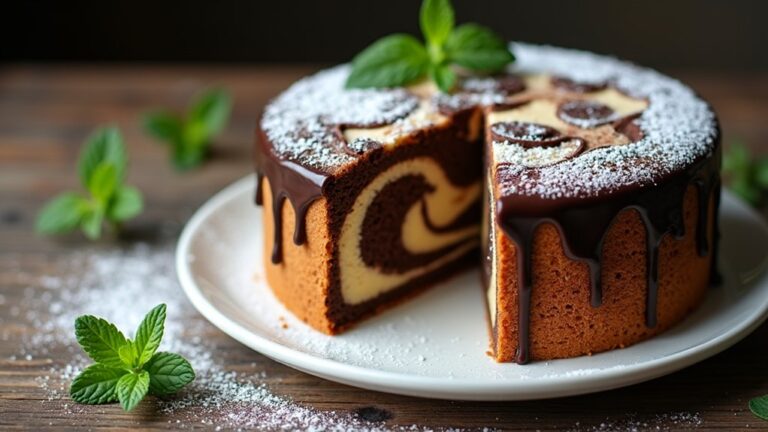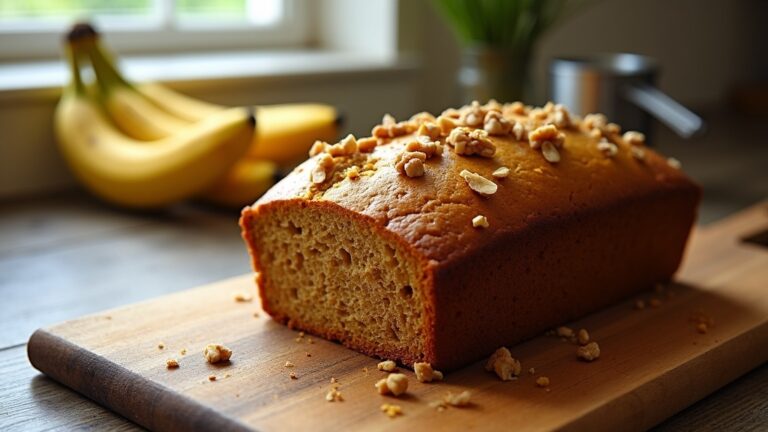Sponge Cake Recipe
To make a light and airy sponge cake, you’ll need 4 large eggs, 1 cup of sugar, 1 cup of flour, and a few other simple ingredients. Start by beating the eggs and sugar until thick. Gently fold in flour and baking powder, then mix in melted butter and vanilla. Bake until golden brown. This versatile cake is perfect for layering with cream or fruits. There’s plenty more to explore in perfecting your sponge cake creation!
Contents
History
As you explore the history of sponge cake, you’ll find its origins trace back to the Renaissance in Europe, where it emerged as a light and airy dessert that captivated palates. This delightful treat embodies a significant moment in culinary evolution, evolving from ancient desserts that were often heavy and dense. The introduction of whipped eggs into the mix allowed for an ethereal texture, making sponge cake a favorite among nobility. Over the centuries, skilled bakers refined the technique, experimenting with flavors and ingredients, transforming this simple cake into a versatile staple. Today, sponge cake represents not just a recipe, but a journey through time, celebrating creativity and freedom in the kitchen. Embrace this legacy as you whip up your own version!
Recipe
Sponge cake is a light and airy cake that serves as a perfect base for many desserts or can be enjoyed on its own with a dusting of powdered sugar. Its delicate texture is achieved by incorporating air into the batter, which is primarily composed of eggs, sugar, and flour. This classic dessert is versatile and can be flavored with vanilla, citrus, or even chocolate, making it a favorite among bakers and dessert lovers alike.
Making a sponge cake is not only rewarding but also quite simple. With just a few key ingredients and some attention to detail, you can create a beautifully risen cake that’s perfect for layering with cream, fruits, or any frosting of your choice. Whether you’re preparing for a special occasion or just want to indulge yourself, this sponge cake recipe will guide you through the process with ease.
Creating a sponge cake is a delightful experience, combining simplicity with the joy of baking a perfect, airy treat.
Ingredients:
- 4 large eggs
- 1 cup granulated sugar
- 1 cup all-purpose flour
- 1 teaspoon baking powder
- 1/4 teaspoon salt
- 1 teaspoon vanilla extract
- 1/4 cup unsalted butter, melted
- Powdered sugar for dusting (optional)
Cooking Instructions:
Preheat your oven to 350°F (175°C) and grease a 9-inch round cake pan. In a large mixing bowl, beat the eggs and sugar together until the mixture is thick and pale, about 5-7 minutes. Sift together the flour, baking powder, and salt in a separate bowl, then gently fold the dry ingredients into the egg mixture, taking care not to deflate the batter. Add the vanilla extract and melted butter, mixing until just combined. Pour the batter into the prepared cake pan and smooth the top. Bake for 25-30 minutes, or until the cake is golden brown and a toothpick inserted in the center comes out clean. Allow the cake to cool in the pan for 10 minutes before transferring it to a wire rack to cool completely.
Extra Tips:
When making sponge cake, make sure that your eggs are at room temperature, as this will help them whip up to a greater volume, resulting in a lighter texture. Be careful to fold the flour mixture gently into the egg mixture to retain as much air as possible, which is critical for achieving that famous sponge-like consistency. Additionally, for added flavor, consider incorporating citrus zest or a splash of almond extract into the batter. If you want to layer your sponge cake, slice it horizontally once cooled and fill with whipped cream, fruit, or jam for a delightful treat!
Cooking Steps
First, you’ll want to preheat your oven to guarantee it’s hot and ready for baking. Next, whisk together the eggs and sugar until they’re light and fluffy, creating the perfect base for your sponge. With the foundation set, it’s time to gently fold in the flour and add a splash of vanilla extract for that delightful flavor.
Step 1. Preheat the Oven First
To achieve that light and airy texture characteristic of a perfect sponge cake, preheating the oven is vital. You’ll want to set your oven temperature to 350°F (175°C) before you start mixing your ingredients. This guarantees that the cake bakes evenly and rises beautifully. While you gather your materials, let the oven work its magic, reaching the ideal heat. It’s not just a matter of convenience; the preheating importance cannot be overstated. If you pour your batter into a cold oven, you risk a dense cake that won’t achieve that delightful fluffiness you crave. So, embrace the freedom of creating; preheat your oven, and set the stage for a sponge cake that’ll impress everyone who tastes it.
Step 2. Whisk Eggs and Sugar
Begin by cracking the eggs into a large mixing bowl, then add the sugar. As you commence this egg whisking journey, take your whisk and plunge it into the mixture. Whisk vigorously, feeling the rhythm as the eggs and sugar combine. You’ll notice the mixture transforming, lightening in color and becoming frothy. This is where sugar incorporation shines, as it dissolves into the eggs, creating a luscious base. Continue whisking until soft peaks form, and the mixture feels airy and voluminous. The goal is to achieve a silky texture that will elevate your sponge cake. Embrace the freedom of movement, letting your whisk dance through the bowl, knowing that each stroke brings you closer to cake perfection.
Step 3. Fold in Flour Gently
Once you’ve achieved that airy mixture of eggs and sugar, gently introduce the flour to the bowl. Begin by sifting flour to guarantee a light, fluffy texture. This step is vital; it helps eliminate lumps and aerates the flour, making your cake rise beautifully. With a spatula, fold in the flour using a delicate motion, scooping from the bottom and turning it over. Don’t rush; you want to preserve that airy quality you created earlier. The goal is to achieve a smooth batter without overmixing, which can deflate your mixture. By embracing this gentle approach, you’ll create a sponge cake that’s not only light but also bursting with potential for flavor and delight. Enjoy the freedom of baking!
Step 4. Add Vanilla Extract
With the flour gently folded in, it’s time to enhance your sponge cake’s flavor by adding vanilla extract. Choose your favorite vanilla variety—pure, Madagascar, or even a splash of Tahitian for a unique twist. Pour in about a teaspoon of this fragrant liquid gold, letting its sweet aroma fill the air. As you mix, imagine how this simple addition transforms your creation, offering a depth of flavor that dances on your palate. Stir just until the vanilla is fully incorporated, ensuring every bite bursts with that delightful essence. This flavor enhancement is essential; it elevates your sponge cake from ordinary to extraordinary, inviting everyone to savor the deliciousness you’ve crafted. Now, you’re ready for the next step!
Step 5. Bake for 25 Minutes
Set your oven to 350°F (175°C) and place your cake batter in the preheated oven for 25 minutes. This is where the magic of baking techniques transforms your mixture into a light, airy cake. As it bakes, the aroma fills your kitchen, tantalizing your senses and heightening your anticipation. Keep an eye on your cake during this vital cake timing—every oven is unique, so adjustments may be necessary. When the time’s up, insert a toothpick in the center; it should come out clean. Don’t rush this moment! Let your sponge cake cool in the pan for a few minutes before transferring it to a wire rack. Enjoy the freedom of creating something delicious!
Nutritional Guide
While indulging in a slice of sponge cake, you might wonder about its nutritional profile. This delightful dessert not only satisfies your sweet tooth but also offers some ingredient benefits worth noting. Check out the caloric content and key nutrients below:
| Ingredient | Calories per Slice | Nutritional Benefit |
|---|---|---|
| Eggs | 70 | High in protein |
| Sugar | 50 | Quick energy source |
| Flour | 60 | Source of carbohydrates |
Sponge cake is relatively low in fat, making it a lighter option compared to other cakes. By using fresh ingredients, you can enhance the taste while reaping the benefits. Enjoy each bite, knowing you’re treating yourself wisely!
Final Thoughts
Sponge cake isn’t just a delicious treat; it’s a dessert that exemplifies simplicity and versatility. You can whip it up for any occasion, whether it’s a casual afternoon snack or a grand celebration. Remember, mastering a sponge cake opens doors to creativity—experiment with flavors and fillings! For cooking tips, verify your eggs are at room temperature for maximum volume, and gently fold in the flour to keep that airy texture. When it comes to serving suggestions, try layering it with fresh fruit and whipped cream, or drizzle a tangy glaze on top. This cake invites you to express your culinary spirit, making every bite a celebration of freedom and flavor. Enjoy the process, and your sponge cake will be a hit!
Frequently Asked Questions
Can I Use Egg Substitutes in Sponge Cake?
Yes, you can use egg replacers in sponge cake! Just remember to adjust your baking tips accordingly. Ingredients like applesauce or flaxseed work well, helping you achieve that light, airy texture without sacrificing flavor. Enjoy experimenting!
How Do I Store Leftover Sponge Cake?
You wouldn’t want your delicious sponge cake to become a sad, stale memory. For proper cake storage, wrap it tightly in plastic and keep it in an airtight container. This guarantees ideal sponge preservation for future enjoyment!
Can I Freeze Sponge Cake?
You can freeze sponge cake easily! Just wrap it tightly in plastic wrap and place it in an airtight container. When you’re ready, thaw the sponge at room temperature for a delightful treat anytime. Enjoy!
What Is the Best Way to Frost a Sponge Cake?
Imagine a painter’s brush gliding across a canvas. You can use various frosting techniques, like spreading or piping, with flavors like chocolate or vanilla. Let your creativity flow, transforming your cake into a delicious masterpiece!
How Can I Make Sponge Cake Gluten-Free?
To make your sponge cake gluten-free, substitute wheat flour with gluten-free flours like almond or coconut. Experiment with baking tips, like adding extra eggs for structure, ensuring your cake rises beautifully and tastes fantastic.
Conclusion
So, there you have it—a sponge cake that’s fluffier than your excuses for skipping the gym! You’ve mastered the art of baking, proving that anyone can whip up a dessert more delightful than their daily drama. Just remember, as you savor each bite, the calories may not count if you eat it with a smile. So grab your fork, dig in, and relish the sweet taste of victory—because who needs a six-pack when you can have a sponge cake instead?






